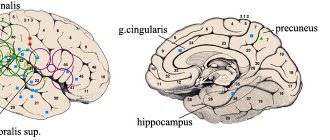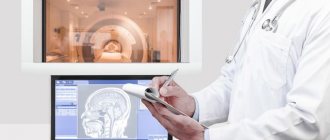Pediatric epileptology is a subsection of neurology devoted to epilepsy at a young age. This is a disease in which repeated attacks occur - paroxysms. The diagnosis can be made only if at least two seizures have occurred, and no other causes other than epilepsy could lead to them.
The fact is that in young children, convulsions can occur when the temperature rises during infectious diseases, intoxication, or the administration of certain medications, as a reaction to vaccinations. Seizures may accompany metabolic disorders such as diabetes.
Children often suffer from this disease: statistics say that it occurs in 7 out of 1000 children under the age of 16. In addition, in childhood the disease occurs with certain characteristics. It is for this reason that pediatric epileptology was singled out.
Signs of epilepsy
Pediatric epileptology identifies the following main symptoms of the disease:
- Grand mal seizure. This is the main symptom of epilepsy. It can begin suddenly, but more often it is preceded by an “aura” - specific sensations, for example, the feeling of a breath of wind, sparks before the eyes, some kind of unclear sound. After this, the patient makes a sharp sound caused by a spasm of the glottis, then he begins to have convulsions that take over the whole body, his breathing becomes noisy, and foam comes out of his mouth. The attack ends on its own, after which the patient may fall asleep and not remember what happened to him, or remain conscious, remaining confused for some time. Seizures may occur rarely or several times a day.
- Minor convulsive seizure. During it there are no general convulsions. The patient makes automatic movements: turning the head, chewing movements and other automatisms. With them, a short-term partial disorder of consciousness is observed.
- Absence. This symptom most often occurs in children, and more often in girls than in boys. It manifests itself in the fact that the child disconnects from reality: he stops speaking and moving, freezes, his gaze is fixed at one point, he does not react to external stimuli. There are no convulsions in this case.
In addition to these striking manifestations, epilepsy in children may be accompanied by:
- sleepwalking;
- mood disorders, the appearance of irritability, sudden changes in mental state;
- a change in character, the appearance of hypertrophied pedantry and accuracy.
Epileptic seizures can occur both while awake and during sleep, quite often when falling asleep or waking up.
Mechanism of occurrence of an epileptic seizure
The root cause of epilepsy is excessive activity of brain cells. It usually occurs in a certain area - the epileptic focus, in the cells of which the excitation processes are modified.
Causes of epilepsy in children
The opinion that epilepsy is an exclusively hereditary disease is not supported by modern doctors. Some of its forms are not inherited, some are a consequence of structural damage to the brain (focal cortical dysplasia, congenital anomalies of brain development, tuberous sclerosis, gangliomas, etc.). It is also impossible to say unequivocally that any diseases suffered by a person lead to epilepsy, but they can accelerate the onset of the disease. These factors are:
- birth injuries, the occurrence of oxygen deficiency at birth;
- traumatic brain injuries;
- cerebral hemorrhages;
- neoplasms in the brain (cysts, hematomas, tumors);
- brain abscess;
- infectious, parasitic, viral diseases;
- meningitis, encephalitis.
What is the danger of epilepsy in children?
- During an attack, a child can be seriously injured, choke on vomit, or bite their tongue or cheek.
- In addition, children have frequent and severe attacks at short intervals, when they simply cannot recover.
- Due to constant attacks, chronic pneumonia can form and mental retardation can develop.
What you need to know about epilepsy
Some consider this disease to be a message from heaven and believe that the patient communicates directly with the gods. Others, on the contrary, attribute to her evil intent and connections with dark forces. However, it is time to leave medieval prejudices for horror stories and myths, and in everyday life one should learn to manage the disease so that it does not interfere with either loved ones or the patient himself. Experts will teach and advise you how to do this.
Epilepsy is one of the most common and socially significant chronic brain diseases. It is caused by pathological uncontrolled discharges in the cerebral cortex. “All over the world, epilepsy is recognized as a curable disease; with adequate therapy, seizures can be controlled in 70% of patients,” says epileptologist Olga Aleksandrovna Makodzeba. “However, in Russia the percentage of curability is much lower - according to various studies in different regions, it ranges from 15 to 50%.” There are only two reasons, one is objective: the lack of competent and experienced neurological care, an accessible diagnostic base, and functioning epileptological centers and offices. The second is subjective, associated with the patient’s misunderstanding of the essence of his disease. “For successful treatment, the interest and active position of the patient and his environment in treatment is very important, and often it is missing,” explains Olga Alexandrovna. “Patients refuse to take anticonvulsant therapy, violate the medication regimen, lead an unhealthy lifestyle, do not comply with the regimen, and do not regularly visit an epileptologist.”
There are more than 40 different epileptic syndromes, with different courses and prognosis, requiring different individual patient management tactics. The choice of treatment strategy depends on the type of epilepsy, gender, age, and individual characteristics. Therefore, an epileptologist should observe a patient with epilepsy.
There are myths, but there are no truths
Why is this happening? Doesn’t the patient himself want to be healthy and lead a full life? The answer to this question is very simple and complex at the same time. People are afraid of what they cannot understand and explain. “The tragic manifestations of convulsive attacks certainly frighten others, but epilepsy is not always convulsive attacks,” the doctor dispels fears. — The range of manifestations of the disease is huge: motor, sensory, and autonomic. It is a big misconception to believe that it is a disease, or that people are sick.” To give patients truthful and reliable information about the disease, to dispel their fears and doubts, to tell them about all the possibilities for treatment and control over the course of the disease, the idea of holding an “Epilepsy School” arose.
“The joint project of the All Medicine Clinic and the regional advisory office for patients with epilepsy and paroxysmal conditions is a series of educational lectures about epilepsy,” emphasizes Olga Aleksandrovna Makodzeba. Experts are confident that if you talk about the disease itself, change your attitude towards the diagnosis and help you find your place in this world, be active, then such joint work of the patient, his environment and the doctor will lead to the best result.
Does epilepsy interfere with motherhood?
One of the lectures will be entirely devoted to the problems of epilepsy in women. The female body differs from the male body in neuroendocrine, metabolic and other features. In addition, motherhood is very important for women, and if they have epilepsy, many of them refuse pregnancy, believing that it will not lead to anything good. Is this really so, and what other fears can prevent your cherished dream from coming true? You can find out at a consultation with an epileptologist at the All Medicine Clinic.
The doctor’s task is to prepare the expectant mother for a successful pregnancy, to convince her that this is possible, especially since contraindications to pregnancy greatly prevent women from carrying and giving birth to a healthy baby, experts believe. “Women are afraid to take anticonvulsants during pregnancy and stop taking them, which leads to an increase in seizures and a deterioration in the woman’s well-being and can cause reproductive losses. — According to the specialist: choose safe drug therapy - the drugs themselves, their dosage, regimen, and be ready to control your condition. How to achieve this will be discussed in the lecture. In addition, experts will tell you how high the risk of heredity for epilepsy is, how to find out whether a particular woman has it or not, in which cases you should seek help from a geneticist, and much more.
A neurologist-epileptologist will talk about the tactics and strategy for treating epilepsy in this particular case at a consultation. “My own clinical experience shows that the better the patient understands what is happening to him and what opportunities there are to overcome the disease, the faster a good therapeutic effect can be achieved,” says Olga Aleksandrovna Makodzeba. “If a patient knows why he should take medications for a long time, the dangers of irregular use, and how to overcome the unwanted effects of anticonvulsant therapy, this allows him to achieve remission as quickly as possible, which is the ultimate goal of treating most chronic diseases.”
At a consultation, specialists will tell you in what cases certain drugs are used, what needs to be done if one drug does not help, and what treatment tactics should be chosen. In addition to drug therapy, surgical treatment methods are also used in resistant cases. You shouldn’t be afraid of them, you just need to know in which cases they are effective and in which they are not. There is no point in relying on the absence of a neurologist or specialized specialist at the local health care facility: unfortunately, it will not be possible to postpone the disease to another, more convenient time. The patient must know what he can do himself in diagnosis and treatment, and be interested in finding information.
In 2021 At the All Medicine Clinic on Kaslinskaya, 24a, the “School of Epilepsy” project was carried out for the first time in the Chelyabinsk region. Anyone who was interested in the problems of people with epilepsy could take advantage of this unique opportunity, in order to possibly change their vision of the disease, realize themselves most successfully and achieve the best results in treatment.
“We conduct our “Schools” on the basis of the All Medicine Clinic. It is good because it has diagnostic capabilities for establishing an accurate diagnosis and prescribing adequate therapy - EEG video monitoring of any duration, the ability to conduct MRI in the epileptology program, monitoring the concentration of basic anticonvulsants in the blood,” the specialist emphasizes. — Anyone can use its services, regardless of registration. At the same time, participation in the “School of Epilepsy” is free and is of an informational and not commercial nature.”
Both patients themselves and their parents, relatives, and friends who want to know more about this disease can take part in the work of the School of Epilepsy. Pre-registration by phone 240-03-03 is necessary for feedback and fruitful organization of the learning process itself.
The classes are conducted by epileptologist Olga Aleksandrovna Makodzeba.
Currently, it is planned to hold the next “School of Epilepsy” in the fall of 2021.
Diagnosis of epilepsy
- Before making a diagnosis of epilepsy, a specialist in pediatric epileptology finds out all the nuances of the course of attacks: their frequency, what preceded them. Talking to parents who can describe their child's seizure in detail is one of the key points in diagnosing epilepsy.
- To exclude any other causes of seizures, laboratory and instrumental examinations are prescribed, as well as consultations with highly specialized specialists - a cardiologist, endocrinologist, gastroenterologist and others.
- To clarify the diagnosis, electroencephalography (EEG) is performed. With its help, the bioelectrical activity of the brain is assessed and the area of increased excitability is determined.
- A study such as Video-EEG monitoring is also used, in which, simultaneously with the instrument readings, the behavior and paroxysms described by the patient’s parents are recorded on a video camera.
- Computed tomography and magnetic resonance imaging (MRI) may be prescribed.
Forms of epilepsy
Taking into account the cause of the disease, the following forms are distinguished:
- idiopathic;
- symptomatic;
- cryptogenic.
In idiopathic forms, there is no apparent cause of the disease, and most of these neurological disorders are hereditary. Symptomatic forms include forms of epilepsy with an established etiology and confirmed changes in the brain. If the disease appeared presumably as a result of brain damage, but there is no convincing evidence of such damage, it is classified as likely symptomatic, or cryptogenic forms.
Can epilepsy be cured?
The prognosis of the disease is directly related to its form. Benign forms of epilepsy that occur in childhood do not necessarily require drug therapy and disappear with age. In the process of treating adults, when it is possible to achieve the disappearance of attacks and remission, the doctor may decide that there is no need to continue taking antiepileptic drugs. But there are also forms that require medication for almost the entire life of the patient, even despite complete remission.
In our clinic, appointments are conducted by neurologists who have high qualifications and practice in the field of neurology, as well as titles, degrees and state awards. You can receive other qualified medical care at the Neuro-Med pediatric and adult neurology clinic in Moscow.
What it is?
Many people have heard about epilepsy and mistakenly attribute it to mental illness. But that's not true. Epilepsy affects the nervous system and is characterized by the presence of lesions. This neurological disease is accompanied by seizures. The patient cannot predict the onset of an attack. Epilepsy is truly dangerous because of its unpredictability. Diagnosis and treatment of the disease includes a number of studies and methods that contribute to an accurate diagnosis. There is no need to panic if you have had a single attack. This does not yet indicate the presence of a diagnosis. When seizures recur and are severe, then there is reason to begin treatment for epilepsy.
The disease often develops in childhood, but it is not included in the list of purely childhood diseases. There are cases where patients learned their diagnosis in adulthood. Epilepsy is inherited in 10% of cases. In adults, the disease develops against the background of other diseases. For example, with brain tumors. Alcohol intoxication is a common cause of this disease. Alcoholic epilepsy is included in a group of pathological conditions characterized by the development of convulsive or non-convulsive seizures associated with alcohol consumption.
The most common forms of epilepsy are:
- Febrile seizures are only partially associated with epilepsy because patients do not require daily antiepileptic drug therapy. Mostly, seizures occur in children aged 3 months to 6 years.
- Benign rolandic epilepsy is characterized by infrequent, mild seizures that occur primarily during nighttime sleep. But sometimes patients need to take antiepileptic drugs.
- Juvenile myoclonic epilepsy is highly treatable. Stable remission is observed in 75–85% of patients. The attacks are mild and occur mainly after waking up.
- Infantile spasms is an epileptic syndrome observed in children aged 3-7 months. It stops when the child is 2-4 years old, but there is a danger that infantile spasms will develop into another form. 1/5 of cases of infantile spasms subsequently develop into Lennox-Gastaut syndrome. A child's seizures may last only a few seconds, but may occur repeatedly throughout the day. Children suffering from this form of epilepsy experience psychomotor impairment or delayed intellectual development.
- Lennox-Gastaut syndrome is quite rare. It is characterized by a combination of attacks of several types and their resistance to drug therapy. This form is difficult to treat, but sometimes it is possible to achieve partial control over the seizures.
- A form of reflex epilepsy usually develops during adolescence. The disease is diagnosed more often in girls than in boys. The causes of attacks are external irritating factors. In approximately 50% of patients, seizures occur only in response to rhythmic light stimulation, and in other cases they are triggered by flashing lights. Sometimes attacks appear spontaneously.
- Temporal lobe epilepsy is one of the most common types of epilepsy, which is characterized by the location of the epileptic focus in the temporal region of the brain. This form is the most difficult to treat; in 30% of cases, drugs have no effect at all. The onset of a seizure in temporal lobe epilepsy is usually expressed by involuntary movements. In rare cases, the patient freezes in an unnatural position during an attack.
- Frontal epilepsy (frontal epilepsy) is a severe form of the disease. The attacks begin suddenly and end quickly. Due to the nature of the disease, it is difficult to diagnose.
Each form of epilepsy has its own differences in manifestations. But is it possible to cure epilepsy if you consult a specialist in time? This is possible if you see a doctor on time, do not ignore the symptoms, and follow all the recommendations. If you were once diagnosed with epilepsy, be prepared for the fact that you will now have to be constantly checked. Treatment is prescribed based on the individual characteristics of the patient: age and general health. For example, epilepsy can be successfully treated in infants and young children. For this purpose, special therapy is used, which is aimed at eliminating the occurrence of seizures and restoring impaired brain functions.
Treatment of epilepsy in older children mainly involves taking medications to control seizures and reduce the risk of relapses.
Expert opinion
Author: Vladimir Vladimirovich Zakharov
Neurologist, Doctor of Medical Sciences, Professor, Head of the Center for Diagnostics and Treatment of Memory Disorders
Epilepsy has remained a serious and dangerous neurological disease for many years. The difficulty of diagnosis lies in the variety of clinical forms of epileptic seizures. At the Yusupov Hospital, patients are examined by qualified neurologists and epileptologists with many years of experience. Diagnosis is carried out using modern medical equipment. Doctors use EEG, CT and MRI. The blood test is assessed in a modern laboratory.
If you follow medical recommendations for the treatment and prevention of epilepsy, more than 60-70% of patients achieve long-term remission. The therapy provided must meet quality and safety standards. At the Yusupov Hospital, each patient is given an individual treatment plan. The prescribed medications are included in the list of the latest European recommendations for the treatment of epilepsy. In order to reduce the risk of seizure recurrence, neurologists and epileptologists at our hospital provide patients with personalized preventive recommendations. This approach to treatment distinguishes the Yusupov Hospital from other medical institutions in the capital.







